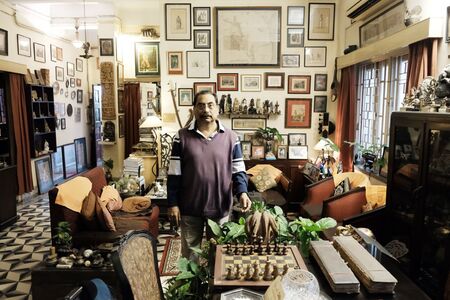Dilip Banerjee the photographer came home recently to discuss a photo essay that he is planning on Calcutta. Whilst home he said that one of the attractions was to see the many paintings and artifacts and in awe inside the house shared: this is like living inside a museum.
No one comes to our home to see the books in the library. Most visitors are attracted to the huge wall with all kind of paintings, engravings, maps , objects like: sword, pistol; hanging. Not necessarily in any order. As my sister, Prantika posted : It has become a ‘celebrity wall’. People burst into tears at the sight of the collection of artifacts from Satranj ki Khilari, which to them is a reminiscent of Satyajit Ray.
The humble collection of books is rather less celebrated, commemorating my father, Nirmal Chandra Kumar, the first antiquarian of Calcutta, who for his better life spend collecting books, many that would forward the career of his friends.
Living in a museum is the dream of many a curious child, and of many a curious adult too. Even mine. Many of my father’s friends like Satul Kaku, Radha Prasad Gupta, have spent nights at my home. Maybe, researching, but the whole night. I will not say, living in a museum but definitely in a library all night with only books and coffee for companion.
Recently there is a trend of Sleep-over Museums. There are Major venues offer a taste of it in sleepovers — London has “Dino Snores” at the Natural History Museum, “Astronights” at the Science Museum, and in the US you can spend the night at the American Museum of Natural History in New York, the Spy Museum in Washington DC and Los Angeles’ National History Museum, to name a few. Who can resist the thrill of spending a night among the exhibits and waiting for something magical to happen, as in the 2006 film Night at the Museum? Yet living in a museum is a far more unusual experience.
However, let me share with you, that when I have a new acquisition and addition to my collection, I do get up often at night to see it over and over again. The painting of Ravana by Bamapada Banerjee is one of them. The character of Ravan, unlike the usual, was so firmly depicted that I could not resist waking up many times at night to appreciate. Or for that matter a Pencil sketch of Rabindranath Tagore by Hemen Majumdar, known specially for his nude study left me gasping for breath at night during sleep for the fine work, comparable only to Leonardo.
I have always lived among books, from childhood so it is no big deal. But still it leaves me in awe. I have shifted out of the original habitat of my ancestral home in Taltala, off Jora Girja and have housed the collection in my present home, inheriting much of the collection from my father and adding to it. I moved into the house with my family and oversaw the process of turning my home into a visual collection. Much of the Paintings, Maps, and Engravings started coming up in the wall and many creeping up from the floor.
Abhishek, my son, inherited the position and started stealing from the main collection to put it up in his room. So there you have the first Celebrity Poster of Queen Victoria in a W D & H O Wills’ Poster in Lithographic reproduction. “It’s a passion, it’s a life,” says the 23-year-old as he shows his friends around, handling Kumar’s precious items — sculptures, ceramics, tiles, his delicate pipe collection — with a mixture of reverence and ease.
Then there is the sun light-flooded library, where two Victorian chairs and a table are surrounded by bookshelves and potted plants, Abhishek’s favourite spot. “My father always told me to look after the house as if Saraswati will visit any moment,” he adds.
Abhishek has spent all of his childhood in the midst, and started helping me out with maintaining the collection. More than 500 people visit our home each year, including: historians, film-makers, authors and simply our dear friends. “Every day I learn something different,” says Abhishek. “The best people visiting are just normal people for me — a lot of them have known me since I was a child.”
In the library room, set up to echo the Albrecht Durer print hanging on the wall sits various antique chairs with a stand by the side holding a copy of the first printed Constitution of India. It feels like someone was just sitting here going through the pages of the Lithoprints directed by Mastermashai, Nandalal Bose.
There are few places where the lines between life and death, fiction and reality, present and past are so deliberately blurred. One of them is the library. Who can resist the thrill of spending a night among the exhibits waiting for something magical? Mingled with the belongings of the antiquarian: pipes, wooden card holder, magnifying glass, wooden ruler, and brass insignia: all incongruously on a table with an engraving of Vidyasagar mounted on an antique frame.
My ancestral home at Taltala on the other hand, was a presence almost as godly as that of the library of Jorge Luis Borges. My father slept in the library with his books and prints. Seldom did he disappear indoors only returning the next moment. Sometimes when he had a visitor early, hunting for some kind of printed material, visiting his friend to help, there would be messy unmade bed — a mattress on pallets, rainbow blanket strewn across. People often mistake it for his bedroom, but that was through the door opposite. All his friends were aware of the house and books and was well aware of “the swirl of things” in Kumar’s House history: he was among the greatest influences on a generation of artists, from filmmaker to fiction writers, folk musician to folk artist; actors to activists, writer to wanderer; teachers to travelers -more so perhaps than any art critic or editor of his times.
We live in a home , with the memory of my father has turned it into a curious fiction, filling it with objects, sounds and smells to create the experience of stepping into “a living home” and to tell the story of a man who spend his whole life studying antiquity. He was Nirmal Chandra Kumar, my father, the first antiquarian in India.
When I tell people, they invariably ask me: Who is the second ?
Image : Dilip Banerjee

